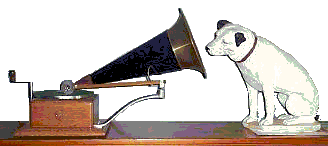
All records prior to about 1925 were recorded "acoustically" (or "mechanically").
They were recorded without the use of any microphones or electronic amplification.
Emile Berliner invented the method of recording onto a rotating zinc disk covered with a thin chemical coating.
The performers would sing or play into a horn driving a diaphragm connected to a needle.
As the disk turned the needle would trace the signal onto it scratching off the coating.
The disk was then immersed into acid to permanently burn the tracing into the zinc.
From this master recording a negative could be made to stamp out the records.
This is about the same as a modern telephone call.
Contrast this with modern recordings which can record from 20 Hertz to 20,000 Hertz.
While these recordings can be filtered to reduce noise, frequencies that were not recorded on the original records will of course still be absent.
You should not expect these antique recordings to sound as good as modern recordings.
If you have any questions, please e-mail me at
swezeyt@winternet.com.
Thank you for your interest in acoustical recordings
(c) 2007, Thomas F. Swezey. All rights reserved.